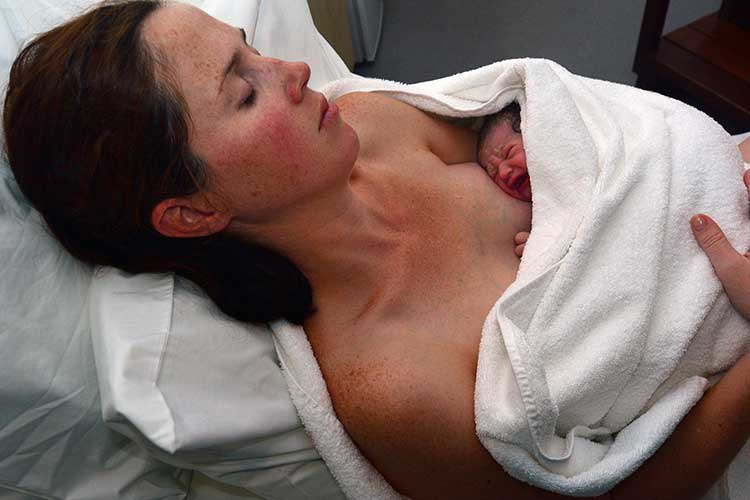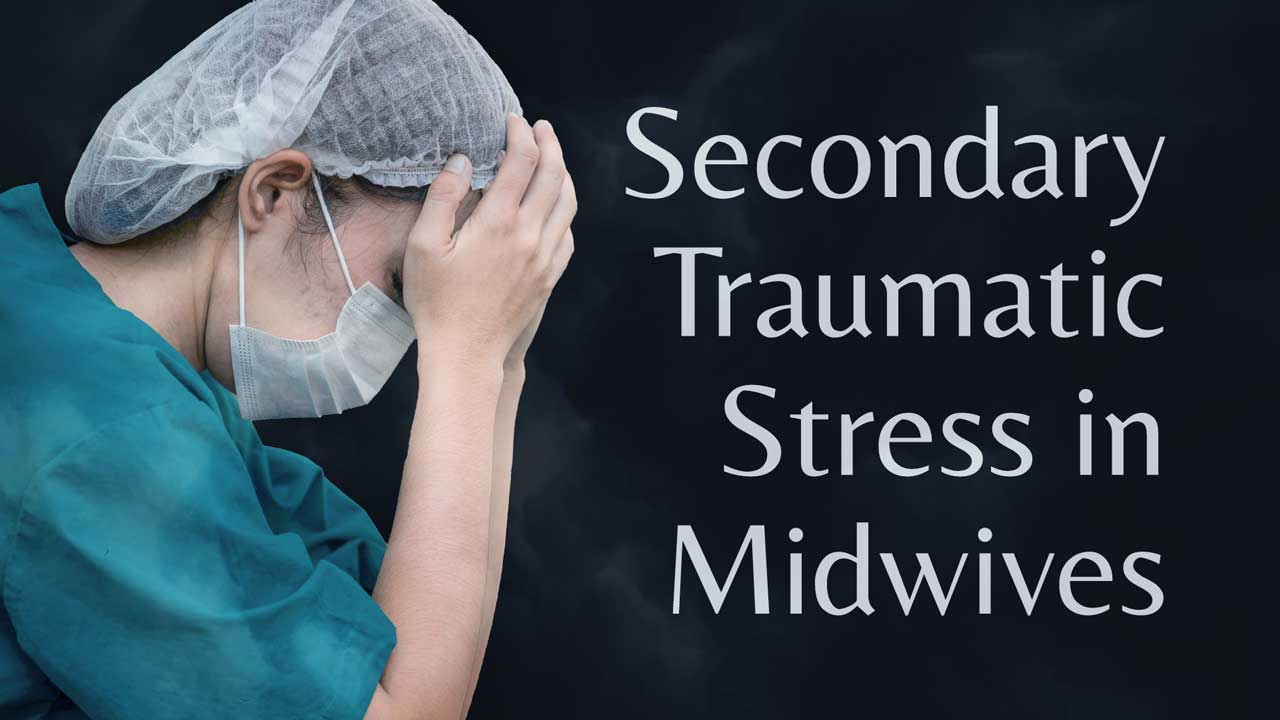Compassion fatigue and burnout are common among all healthcare professionals, but midwives, in particular, can experience high levels of secondary traumatic stress.
Yet, the emotional cost of caring goes largely unrecognised, leaving many midwives feeling emotionally divorced from their work or wanting to quit the profession altogether.
The Emotional Cost of Caring
Whilst it’s true to say that any healthcare professional, working in any speciality, can experience compassion fatigue and burnout, the high degree of empathic identification that characterises the midwife-birthing parent relationship places midwives at particularly high risk of experiencing secondary traumatic stress (Bingham et al. 2023).
Secondary traumatic stress is known to be an occupational hazard for midwives, as they may develop symptoms of post-traumatic stress disorder (PTSD) following exposure to their traumatised patients (Pinney 2024).
Midwives are particularly susceptible to this type of stress because of the close bond that is often formed with the birthing parent and the strong emotional reactions that can arise in response to witnessing birth trauma (Bingham et al. 2023).
According to a study conducted by Leinweber et al. in 2017, almost one-fifth of Australian midwives surveyed met the criteria for probable PTSD.
Creedy et al. (2017) agree, suggesting it’s a problem that often goes unacknowledged and underreported, with a prevalence of 20% to 59% noted in both the United Kingdom and Australia.
Most researchers agree that the incidence of midwives with secondary traumatic stress is shockingly high.
Why is This?
One probable answer to this question lies in the fact that midwives are increasingly being asked to work with a disjointed and fragmented care model that requires them to override their natural yearning to be ‘with woman' and remain present and intuitively aware throughout labour and delivery (Williams 2018).

Risk Factors for Secondary Traumatic Stress in Midwives
Physical damage, powerlessness and fear are three key elements generally associated with traumatic stress.
For midwives, these criteria are all too often a reality of their working day. For example:
- Long shifts with inadequate breaks may cause physical damage
- Lack of control organising off duty can be stressful
- Being moved by managers from area to area with little notice creates feelings of powerlessness
- Constant anxiety about making a mistake in a litigious culture creates a climate of fear.
(Davies 2016)
Not everyone is susceptible to the same stressors, however, and this can make seeking a universal solution challenging.
Midwives who are at higher risk of burnout tend to:
- Have inadequate workplace support or a stressful work environment
- Work under non-continuity care models (e.g. shift work)
- Be younger in age
- Have less clinical experience
- Have an intense workload
- Experience conflict with coworkers
- Feel unsatisfied in their role
- Have a lack of support from family and coworkers
- Earn a low amount
- Not have children.
(Sidhu et al. 2020)
The Royal College of Midwives (2018) also suggest the following factors may be associated with high levels of professional burnout:
- Perceptions of low levels of resources
- Perceived low levels of management support
- Lack of professional recognition and opportunities for development.
Conversely, midwives who have responsibility for their own caseload and shift patterns may cope significantly better with stress than midwives who work full-time within a standard care model.
Shame, Blame and Guilt
When a traumatic event occurs during labour or delivery, midwives can be left feeling unprepared, unsupported or simply overwhelmed, with residual feelings of failure or even personal bereavement.
As Patterson (2019) suggests, when organisational demands leave midwives unable to provide compassionate care or feeling complicit in poor care, this creates a sense of shame, blame and guilt that only serves to deepen the hurt.
Added to this, the under-resourced, pressured environments that midwives typically work in mean they may struggle to disengage and process these emotions, leaving them highly vulnerable to secondary traumatic stress and PTSD.
For some midwives, secondary traumatic stress can diminish over time. For others, it can weaken their ability to adapt and lead to future cycles of burnout, increased errors and more stress.
Perhaps worse still is when a midwife loses confidence in the natural process of birth itself. Diminished self-confidence, alongside associated fears of causing harm, receiving criticism or facing litigation, can all lead to increased vigilance, risk management and medical intervention.
Not only can this lead to reduced job satisfaction on the part of the midwife, but it can also raise the level of stress and anxiety for everyone associated with the birth and compromise the level of personal care offered to the patient.
As Patterson (2019) reflects, improving the workplace culture and addressing midwives’ needs will improve not only the working lives of midwives but also their interactions with patients, improving the mental wellbeing of all concerned.

Restoring Resilience
Resilience is said to be a learned process facilitated by a range of coping strategies, such as accessing support and improving self-awareness (Hunter & Warren 2014).
The need for all practitioners to take responsibility for practising self-care and developing resilience is widely accepted.
However, when midwives experience trauma through being prevented from providing high standards of care due to systemic pressures or being disrespected, undermined or bullied, then as Patterson (2019) suggests, the responsibility for improvement should lie with the organisation rather than the individual.
Beaumont et al. (2016) agree, suggesting that cultivating environments that foster compassionate care for the self and others can play a significant role in helping midwives face the rigours of training and clinical practice.
In recent years, the mental health of midwives has come under increasing scrutiny, with a survey conducted by the Royal College of Midwives (2018) indicating that emotional wellbeing is compromised to such an extent that two-thirds of respondents were considering leaving the profession.
As a result of this survey, some important action steps were recommended:
- Introducing evidence-based interventions for workforce wellbeing support
- Ensuring that midwives are given ‘protected’ time to attend wellbeing events
- Providing proactive support for younger, recently qualified midwives
- Facilitating a sense of shared leadership amongst midwives at a team level.
(RCM 2018)

Further recommendations suggest that when midwives experience trauma from witnessing adverse obstetric events or poor interpersonal care towards patients, they require a non-judgemental culture in which their normal human responses and subsequent needs are acknowledged and appropriately responded to (Patterson 2019).
Simple action steps such as providing protected time to talk through events have the overriding benefit of diffusing feelings of self-blame or incompetence. If handled well, they can also become a valuable source of personal growth and enhanced knowledge.
As Creedy et al. (2017) point out, given midwives’ role in promoting perinatal health, the wellbeing of the midwifery workforce warrants close and regular scrutiny.
It’s a view strongly echoed by Beck et al. (2015), who suggest the midwifery profession should acknowledge secondary traumatic stress as a professional risk.
The mental wellbeing of midwives has been ignored for too many years, and yet, it has clear implications for safe practice, staff retention and perhaps above all, maternal satisfaction.
As Creedy et al. (2017) reflect, if midwives suffer emotional exhaustion, they are more likely to be emotionally withdrawn; communicate poorly with birthing parents, their families and colleagues; distance themselves from patients in their care; and ultimately, perform poorly in the workplace.
Topics
References
- Beck, C, LoGiudice, J & Gable, R 2015, ‘A Mixed-Methods Study of Secondary Traumatic Stress in Certified Nurse-Midwives: Shaken Belief in the Birth Process’, Journal of Midwifery & Women's Health, vol. 60, no. 1, pp.16-23, viewed 6 January 2025, https://onlinelibrary.wiley.com/doi/10.1111/jmwh.12221
- Beaumont, E, Durkin, M, Hollins Martin, C & Carson, J 2016, ‘Compassion for Others, Self-Compassion, Quality of Life and Mental Well-Being Measures and Their Association with Compassion Fatigue and Burnout in Student Midwives: A Quantitative Survey’, Midwifery, vol. 34, pp. 239-244, viewed 6 January 2025, https://www.sciencedirect.com/science/article/abs/pii/S0266613815002843
- Bingham, J, Kalu, FA & Healy, M 2023, ‘The Impact on Midwives and Their Practice After Caring for Women Who Have a Traumatic Childbirth: A Systematic Review’, Birth, vol. 50, no. 4, viewed 6 January 2025, https://onlinelibrary.wiley.com/doi/10.1111/birt.12759
- Creedy, DK, Sidebotham, M, Gamble, J, Pallant, J & Fenwick, J 2017, ‘Prevalence of Burnout, Depression, Anxiety and Stress in Australian Midwives: a Cross-Sectional Survey’, BMC Pregnancy and Childbirth, vol. 17, no. 1, viewed 6 January 2025, https://bmcpregnancychildbirth.biomedcentral.com/articles/10.1186/s12884-016-1212-5
- Davies, S 2016, ‘Caring for Future Midwives’, AIMS Journal, vol. 28, no. 1, viewed 6 January 2025, https://www.aims.org.uk/journal/item/caring-for-future-midwives
- Hunter, B & Warren, L 2014, 'Midwives’ Experiences of Workplace Resilience', Midwifery, vol. 30, no. 8, pp. 926-934, viewed 6 January 2025, https://www.sciencedirect.com/science/article/abs/pii/S0266613814000904?via%3Dihub
- Leinweber, J, Creedy, D, Rowe, H & Gamble, J 2017, ‘Responses to Birth Trauma and Prevalence of Posttraumatic Stress Among Australian Midwives’, Women and Birth, vol. 30, no. 1, pp. 40-45, viewed 6 January 2025, https://www.ncbi.nlm.nih.gov/pubmed/27425165
- Patterson, J 2019, ‘Traumatised Midwives; Traumatised Women’, AIMS Journal, vol. 30, no. 4, viewed 6 January 2025, https://www.aims.org.uk/journal/item/traumatised-midwives-traumatised-women
- Pinney, C 2024, ‘Midwives are Vulnerable to PTSD. What can we do About it?’, Nurse & Midwife Support News & Events, 29 January, viewed 6 January 2025, https://www.nmsupport.org.au/news/midwives-are-vulnerable-ptsd
- Royal College of Midwives 2018, Work, Health and Emotional Lives of Midwives in the United Kingdom: The UK WHELM study, School of Healthcare Sciences Cardiff University, viewed 6 January 2025, https://rcm-production.azurewebsites.net/media/2924/work-health-and-emotional-lives-of-midwives-in-the-united-kingdom-the-uk-whelm-study.pdf
- Sidhu, R, Su, B, Shapiro, KR & Stoll, K 2020, ‘Prevalence of and Factors Associated with Burnout in Midwifery: A Scoping Review’, Eur J Midwifery., vol. 4, viewed 6 January 2025, https://www.europeanjournalofmidwifery.eu/Prevalence-of-and-factors-associated-with-burnout-in-nmidwifery-A-scoping-review,115983,0,2.html
- Williams, H 2018, ‘Burnout in Midwifery: An Occupational Hazard?’, HealthTimes Midwifery News, 20 July, viewed 6 January 2025, https://healthtimes.com.au/hub/midwifery/38/news/hw/burnout-in-midwifery-an-occupational-hazard/3504/
 New
New 
